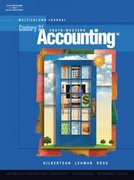Question
Lehighton Chalk Company manufactures sidewalk chalk, which it sells online by the box at $22 per unit. Lehighton uses an actual costing system, which means
Lehighton Chalk Company manufactures sidewalk chalk, which it sells online by the box at $22 per unit. Lehighton uses an actual costing system, which means that the actual costs of direct material, direct labor, and manufacturing overhead are entered into work-in-process inventory. The actual application rate for manufacturing overhead is computed each year; actual manufacturing overhead is divided by actual production (in units) to compute the application rate. Information for Lehighton's first two years of operation is as follows:
Year 1 Year 2 Sales (in units) 3,000 3,000 Production (in units) 3,600 2,400 Production costs: Variable manufacturing costs $ 15,480 $ 10,320 Fixed manufacturing overhead 19,080 19,080 Selling and administrative costs: Variable 12,000 12,000 Fixed 11,000 11,000
Selected information from Lehighton's year-end balance sheets for its first two years of operation is as follows:
LEHIGHTON CHALK COMPANY Selected Balance Sheet Information Based on absorption costing End of Year 1 End of Year 2 Finished-goods inventory $ 5,760 $ 0 Retained earnings 8,700 13,840 Based on variable costing End of Year 1 End of Year 2 Finished-goods inventory $ 2,580 $ 0 Retained earnings 5,520 13,840
Required:
- Reconcile Lehighton's operating income reported under absorption and variable costing, during each year, by comparing the following two amounts on each income statement:
- Cost of goods sold
- Fixed cost (expensed as a period expense)
- What was Lehighton's total operating income across both years under absorption costing and under variable costing?
- What was the total sales revenue across both years under absorption costing and under variable costing?
- What was the total of all costs expensed on the operating income statements across both years under absorption costing and under variable costing?
- Subtract the total costs expensed across both years [requirement (4)] from the total sales revenue across both years [requirement (3)]: (a) under absorption costing and (b) under variable costing.
- Considering the results obtained in requirements 1-5 above, select which of the following statements (is) are true by selecting an "X".
(Please show work)
Step by Step Solution
There are 3 Steps involved in it
Step: 1

Get Instant Access to Expert-Tailored Solutions
See step-by-step solutions with expert insights and AI powered tools for academic success
Step: 2

Step: 3

Ace Your Homework with AI
Get the answers you need in no time with our AI-driven, step-by-step assistance
Get Started


